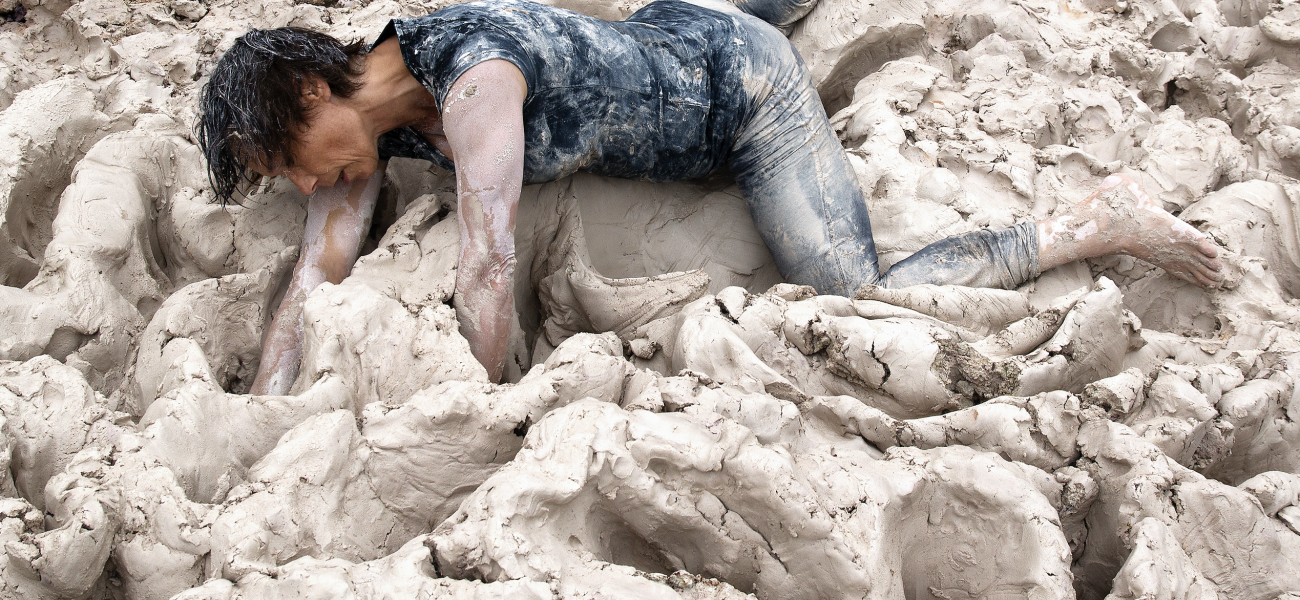Earth, Wind, and Fire
"Described as a ‘true mud person,’ Alexandra Engelfriet works with huge bodies of clay, using her body as a tool with which to form and sculpt. Her work leaves a profound, visceral, and unspoken sense of relation; body and clay giving and receiving, forcing and suffering, setting geological time-scales against the breath of the human body. As an anthropologist interested in the relations between landscape, materials, and the practices of art, I was enthralled by the sheer physicality of Alexandra’s practice, the seriousness of this play clay affords." – Marc Higgin
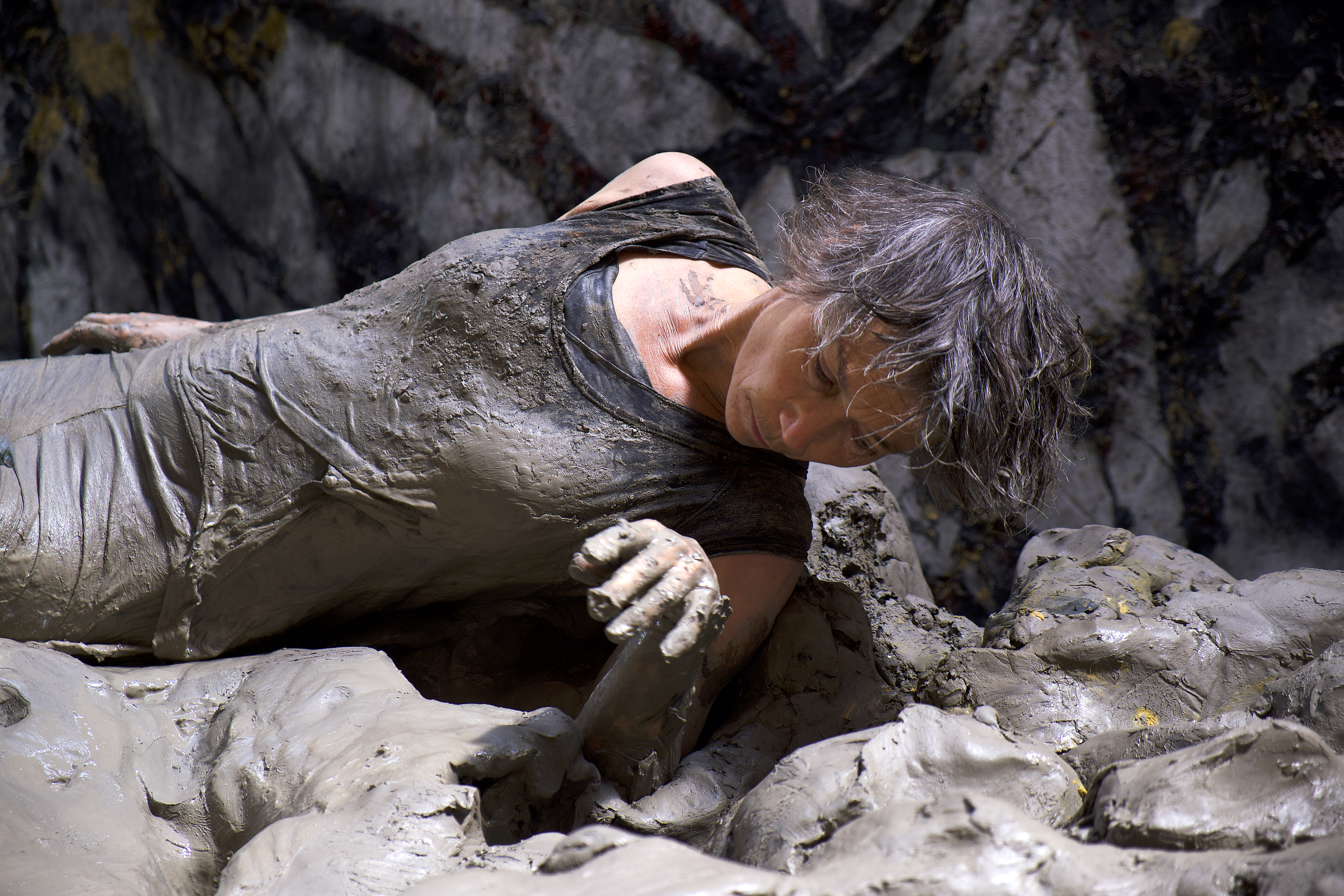
Black Earth
In 1989, a truckload of black earth was deposited on the pavement outside my studio in a basement in the center of Amsterdam. Bringing it into the space and then building it up against one wall to create verticality was a huge effort. It kept falling down, and I spent weeks finding ways to keep it up. During this process, something deep inside my body was awakened, and I felt a strong physical connection to the earth. It was the physical response I had to the material that gripped me – the process rather than the realized concept.
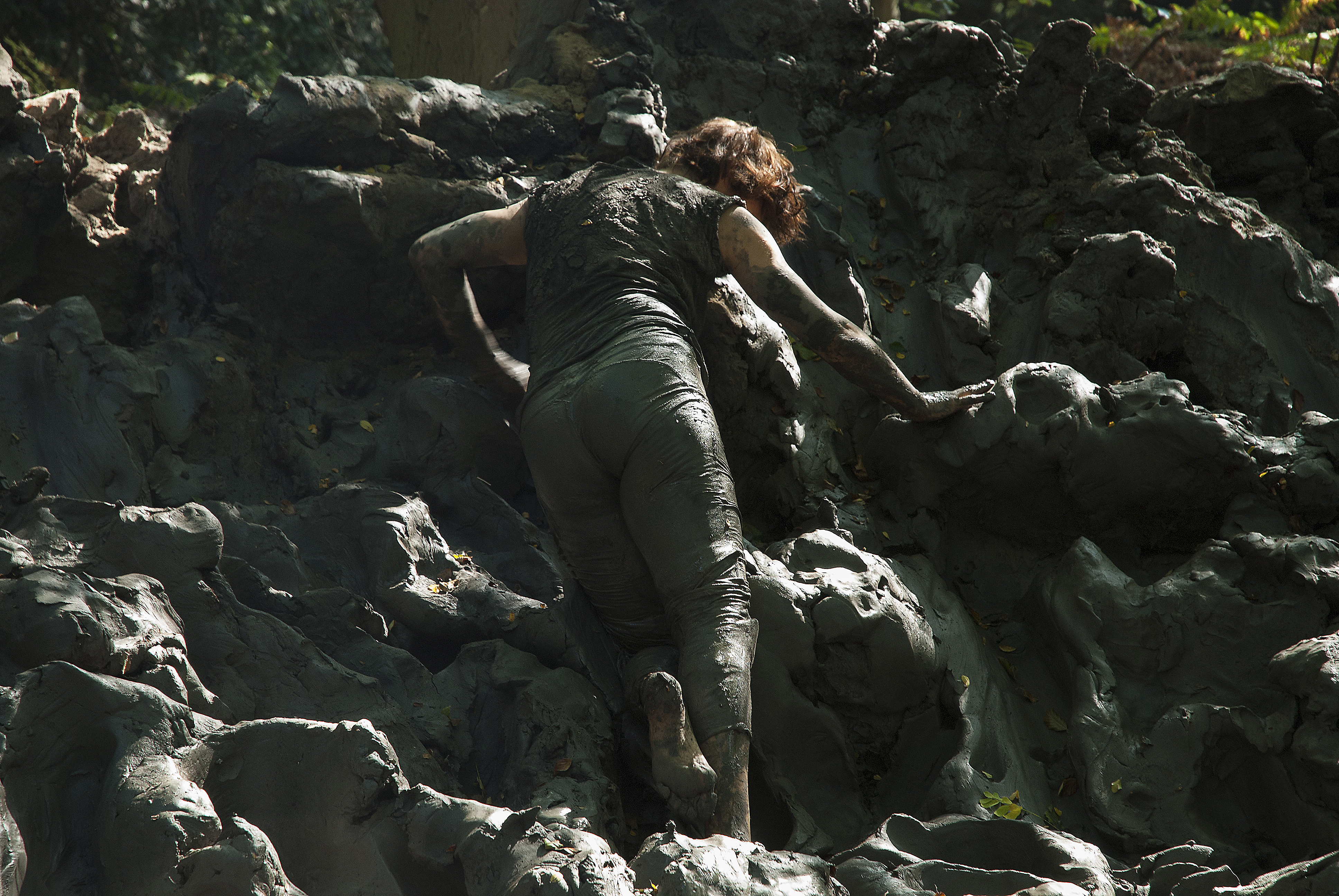
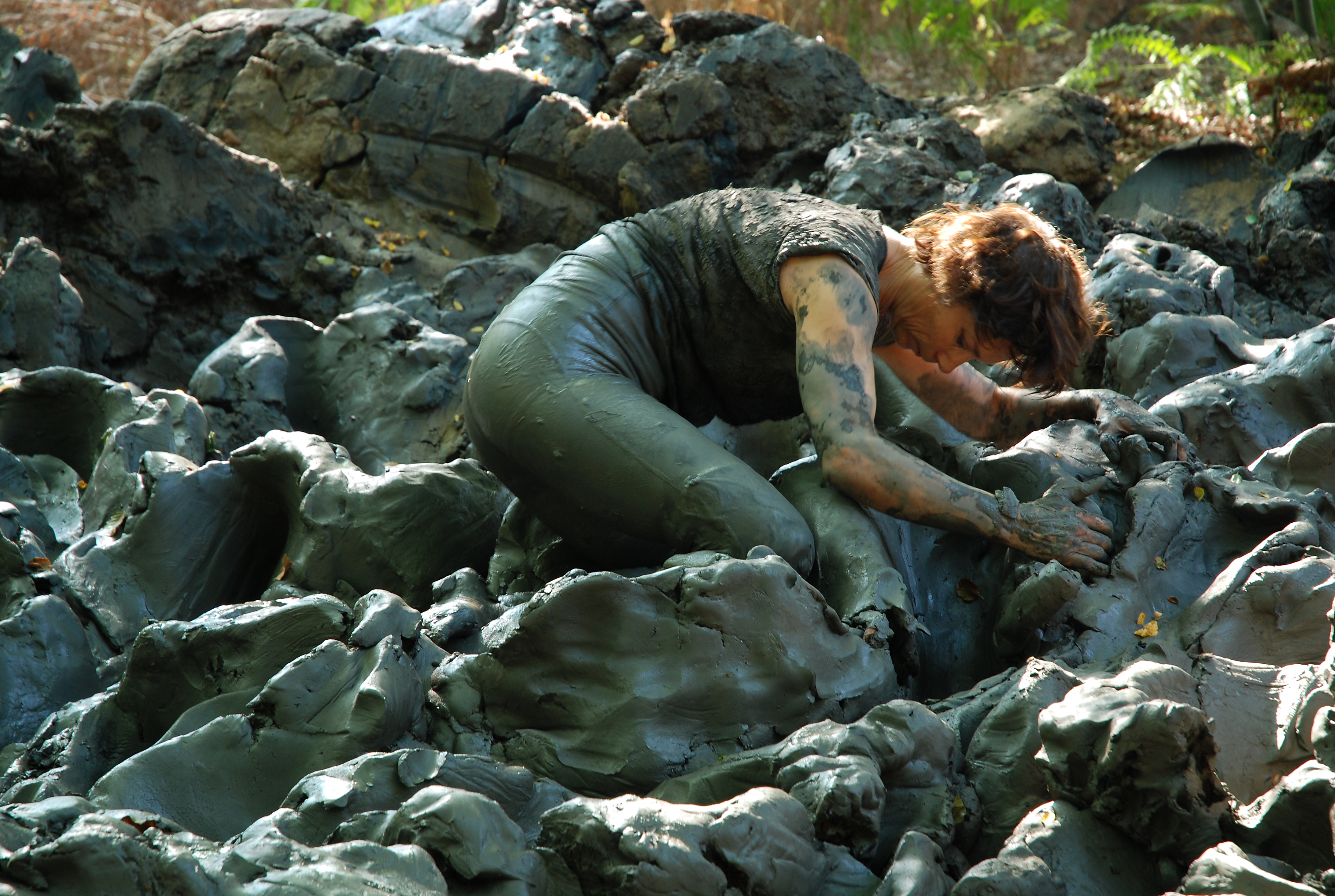
During this period, I often went to Switzerland to experience the shaping forces of the earth in the geological formations of the mountains. I made large imprints of rock surfaces, seeking to merge with the powers deep within the earth by feeling through the surface of the rocks. But until 1998, I wasn’t interested in actually making artwork in the land. A space provided the necessary boundaries to be able to connect to the material itself and in which my explorations could take place. The space became part of the work, a large mould in which the material was shaped.
Clay Space
"Clay is not passive matter but a material with a temporality and life of its own that acts upon us, in and through us. Alexandra Engelfriet’s practice can be read, with Tim Ingold, as a dance of animacy in which both material and experience are transformed." – Marc Higgin
Because of the plasticity of clay, even the smallest physical action leaves an imprint. It is material with which you can engage without preconceived ideas of the end result, which emerges from the process itself. I ordered 5 tons of clay from a brick factory and covered the floor and walls of my studio with it. I worked in and with this same amount of clay for a couple of years, keeping it wet and workable. I became so absorbed in the process that, for a long time, I wasn’t even concerned about the end result. I was interested in what this primal matter, the material of which, in many myths, man is made and from which everything arises and in which everything returns, does to me if I don’t try to control it but, on the contrary, surrender myself to it and let myself be overwhelmed by it. I am interested in the experience this way of working evokes and the way I am transformed by it. Experiences that permeate and become a part of the work.
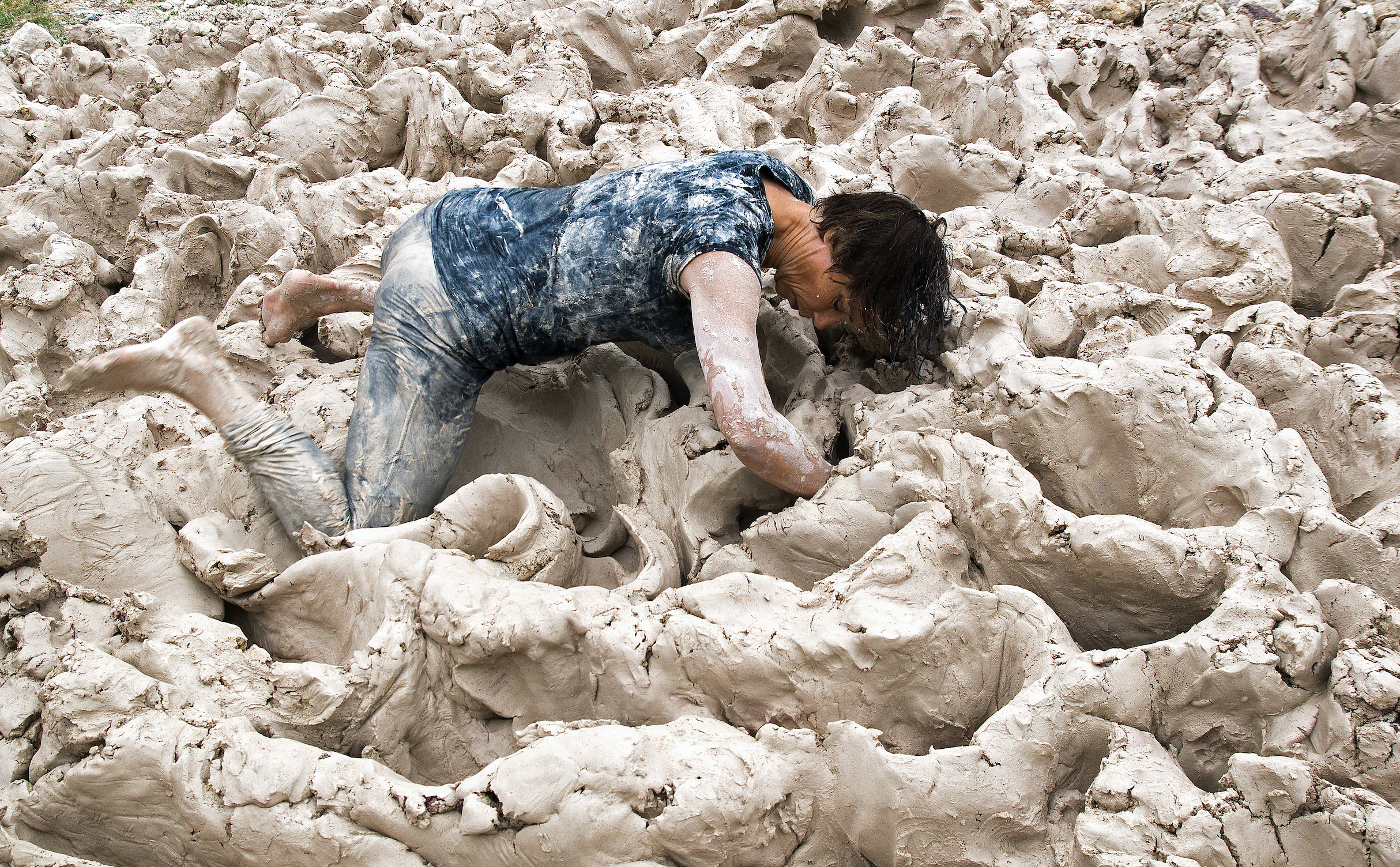
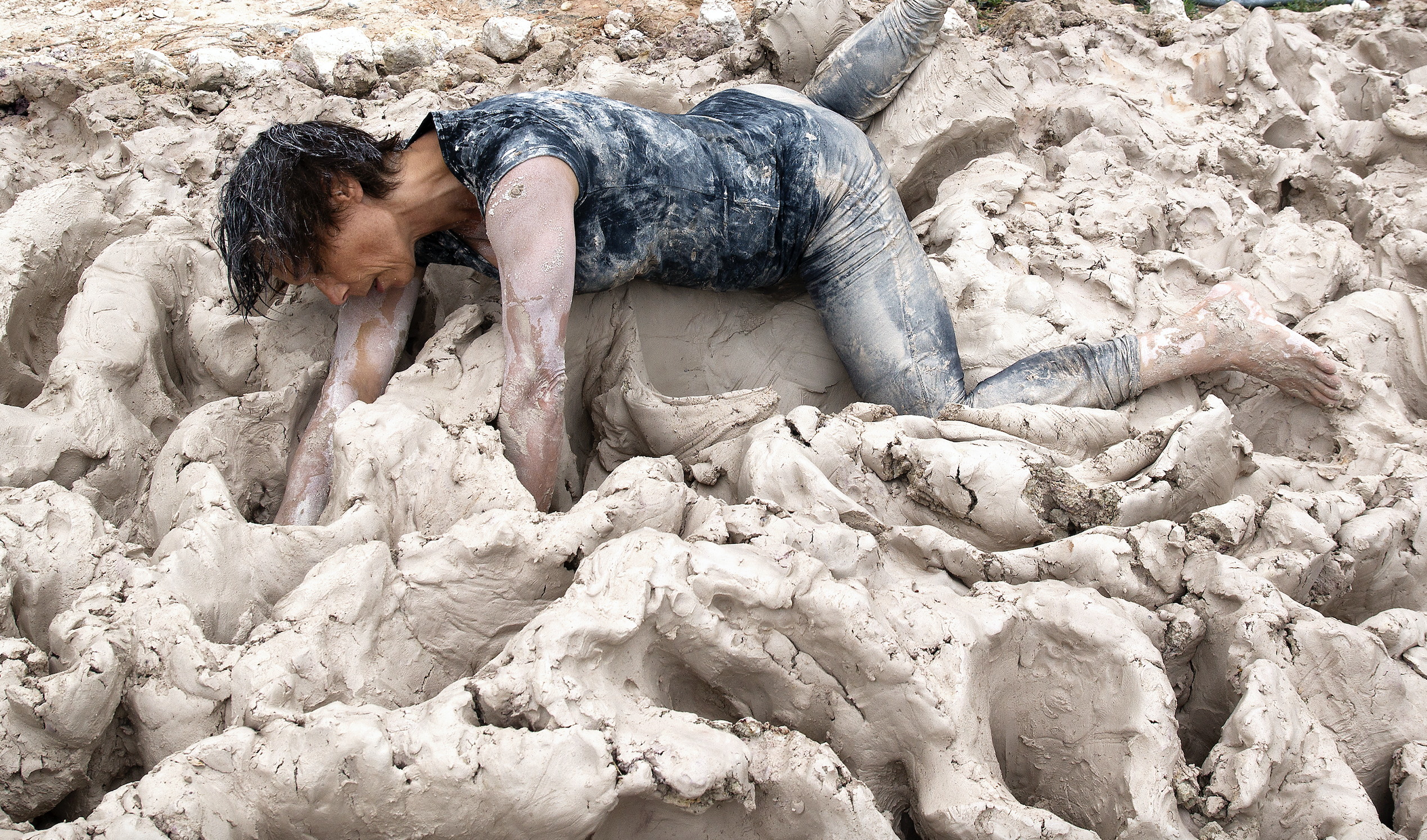
Warmth, sensuality, fullness, power, going back in time before time started – primordial – it is the foundation from which existence comes into being. Closeness, connectedness, plasticity, experience of the body and its inner depths, awareness, presence. It pulls me into direct experience, into concentration; by focusing body and mind, an expansion of consciousness takes place. But also the opposites: coldness, pain, complete weakness, despondency, despair, disintegration, and death. It can destroy, suck you out of existence. Creative and destructive forces. Universal and very private, intimate at the same time.
In the clay, I surrender to something bigger than myself. I search for a correspondence or even a merging with the material when my body becomes clay and clay a body, and the boundary between inside and outside, body and mind, dissolves. The soft clay is my partner in a sensual dance, a process of giving and receiving, body adjusting to clay, clay to body, skin to skin, sentient body merging into sentient earth. The smallest movement of a hip, elbow, or finger leaves an imprint in the tender softness of the material.
The effort and repetition of my movements intensify the experience, opening a kind of trance in which the body takes the lead. I feel a gathering of power and energy, with no limit to my ability to shape the clay and myself. I become more and more plastic and three-dimensional myself, changing shape all the time. Form, content, matter, and mind merging into one. As it is spatially bound, as well as temporally, and unfolds in the present moment, it can be seen as a form of ritual.
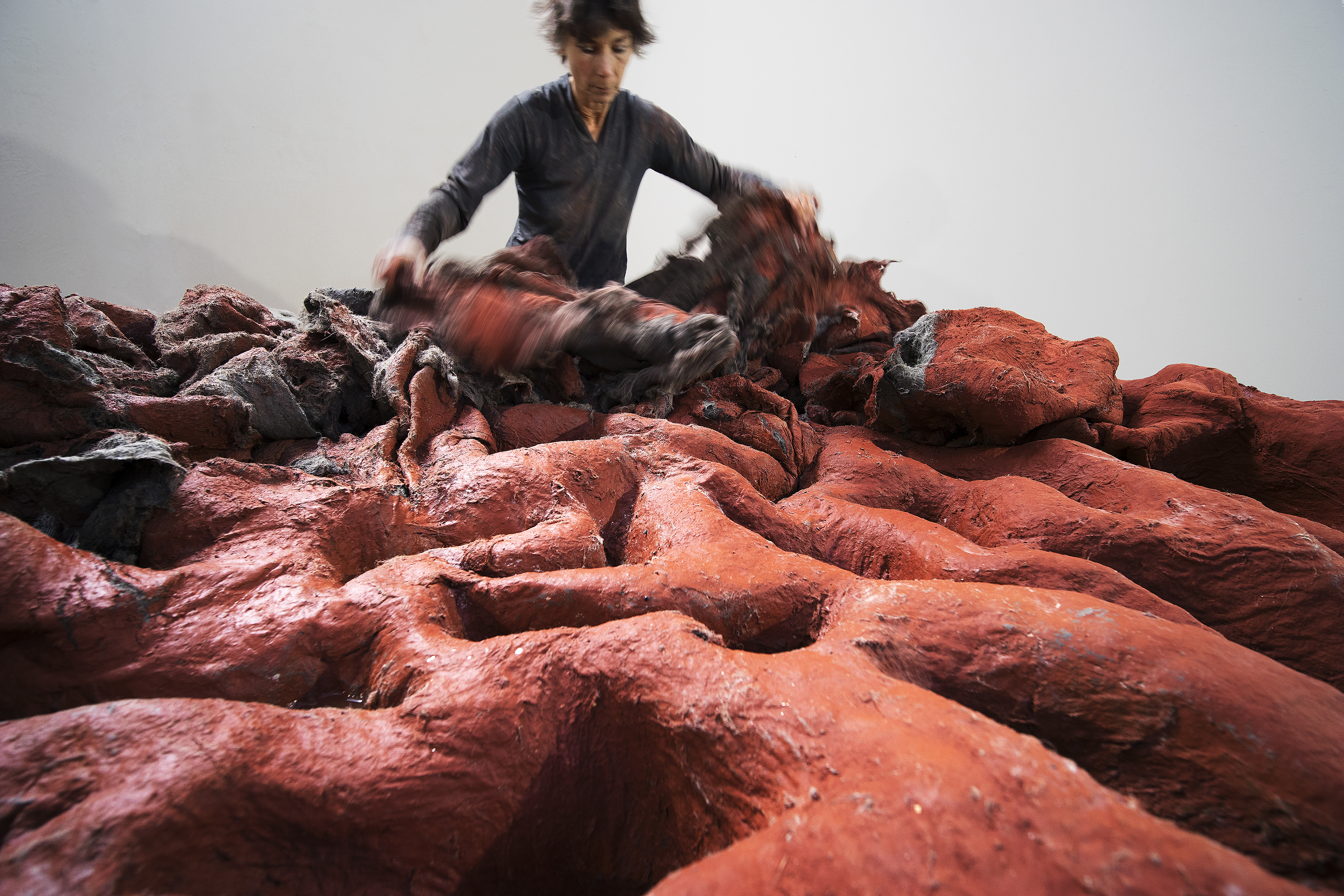
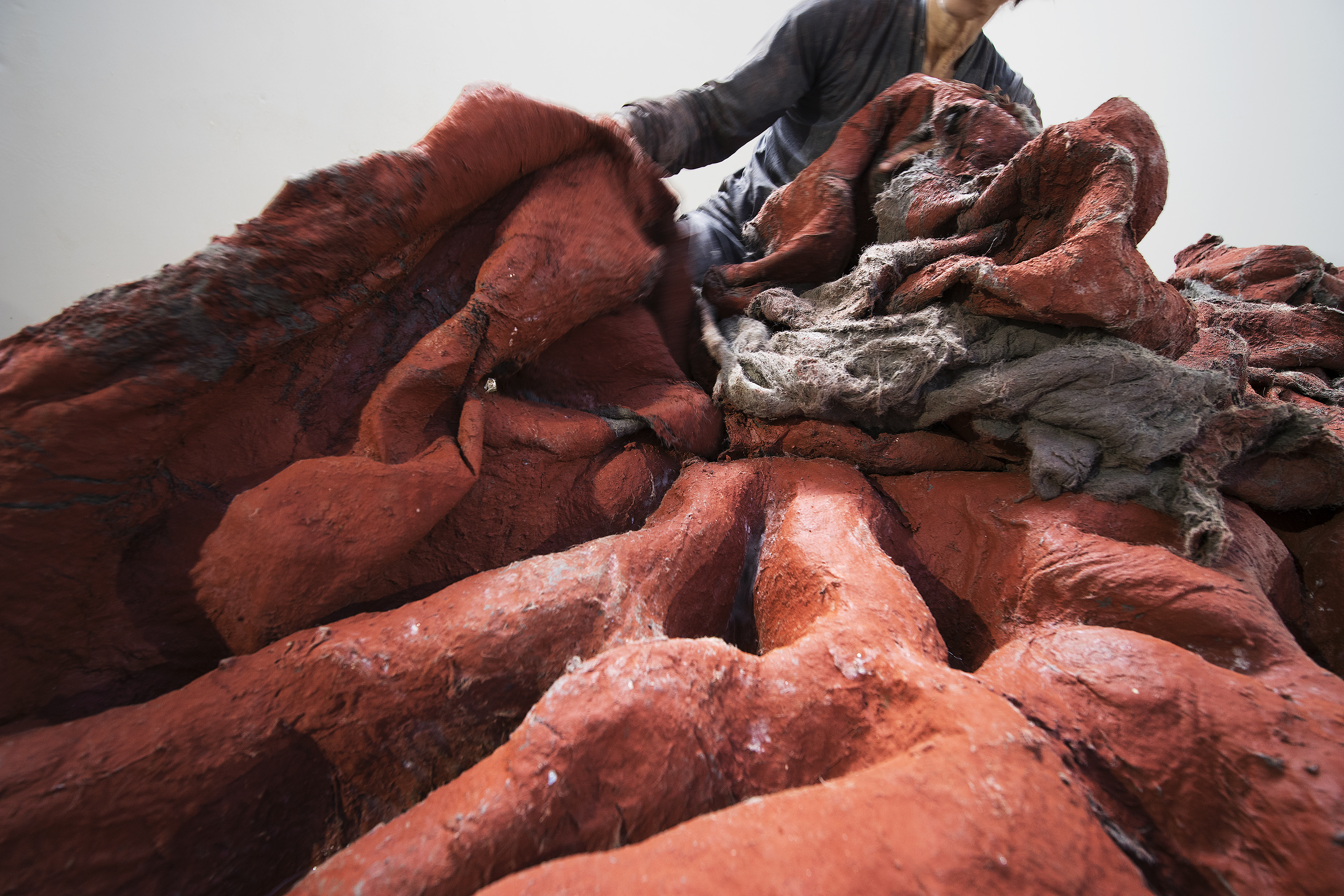 As I work, I multiply gesture on gesture, and imprint on imprint, in which a distinct visual grammar emerges tied to the scale and gesture of my body. Each movement is recorded in the clay and modified by subsequent movements. A sea of clay deeply imprinted by the human body emerges. Experience, process, and artistic result are one.
As I work, I multiply gesture on gesture, and imprint on imprint, in which a distinct visual grammar emerges tied to the scale and gesture of my body. Each movement is recorded in the clay and modified by subsequent movements. A sea of clay deeply imprinted by the human body emerges. Experience, process, and artistic result are one.
"Her posture adapts, her gesture becomes clearer, a rhythm is established and the trace becomes a work, a celebration of a visceral and communicative love of the earth." – Marc Higgin
The dialogue between me and clay has evolved over the years. The process of transformation is irreversible, as process is experience, and experience cannot be undone. I have reached into many layers of the earth and many recesses of my body and mind. By penetrating those deep layers, the wonderful phenomenon takes place that deep inside, I open to the world, to reality as it truly is, fundamentally creative, always changing, every moment full of possibilities. Clay is that fundamental reality, before words and before form.
Mudflats
During a residency in 2000 in the northeast part of the Netherlands, I discovered the mudflats of the Dollard, the estuary of the river Eems, where the sea penetrates the land and goes out again, land and sea mutually shaping each other, a place both water and earth. When the tide is out, a bed of soft silt is exposed.
One of the determining elements while working in the mudflats is that of the rhythm of time, of the tide. When the tide is out, the seabed is laid bare and becomes available for me to work in. After about six hours, the sea irreversibly comes back, first swelling the meandering channels and branched gullies, and then slowly but steadily the waterline creeps up, swallowing the traces I left in the mud. The mudflats disappear beneath the water and become inaccessible. Spending time working in the mudflats every day means living with the tides.
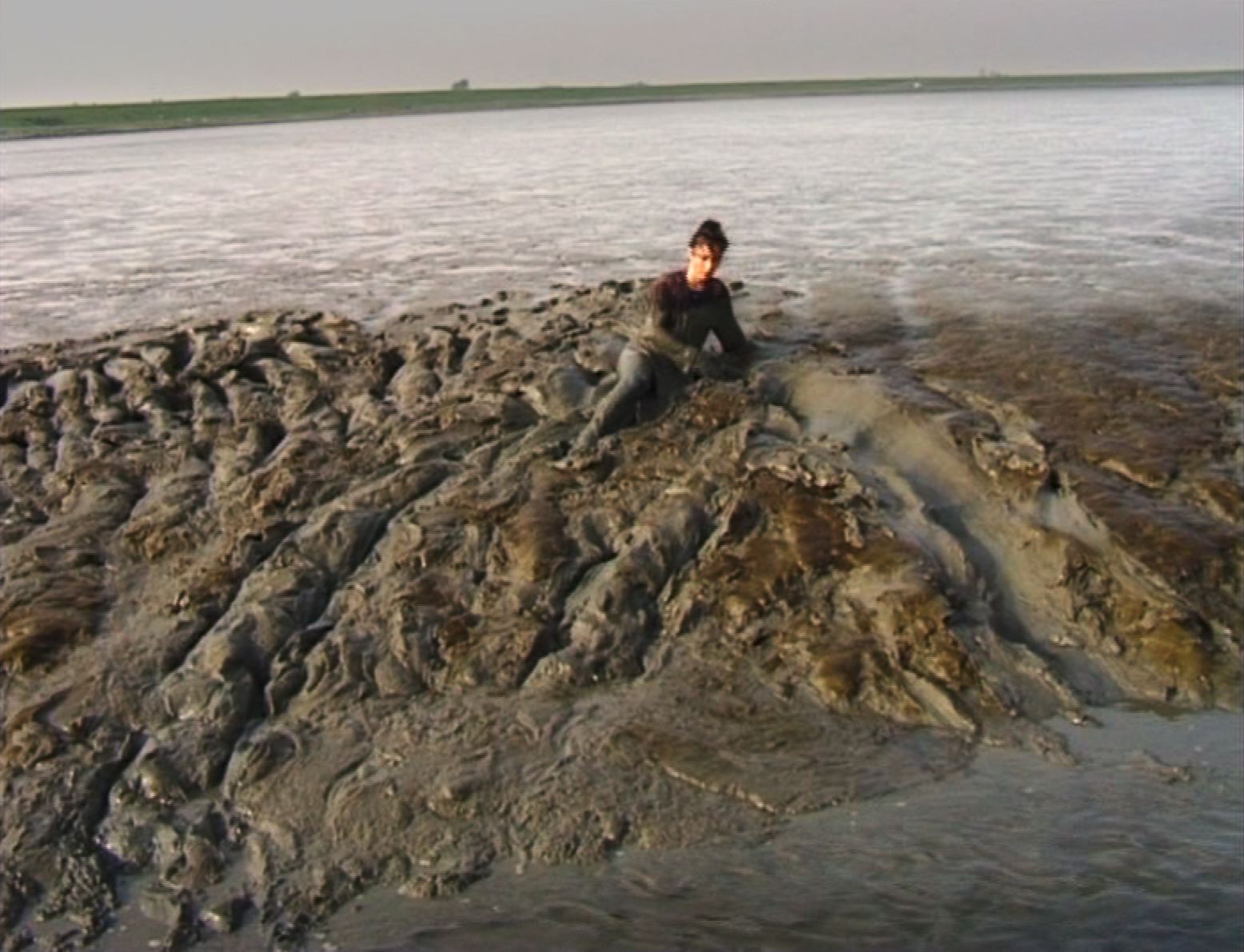 Working out in the wide open space of the wad (mudflat: an area of muddy seaside land which is covered with water at high tide.) is an entirely different experience from working in a confined space. The material is right there on the spot, and it is in a perfect state to immerse myself in. This is unique. Although clay is everywhere, it is very seldom soft enough to work with. The silt is wonderful, sensual, soft, and encompassing when merging into it.
Working out in the wide open space of the wad (mudflat: an area of muddy seaside land which is covered with water at high tide.) is an entirely different experience from working in a confined space. The material is right there on the spot, and it is in a perfect state to immerse myself in. This is unique. Although clay is everywhere, it is very seldom soft enough to work with. The silt is wonderful, sensual, soft, and encompassing when merging into it.
Other elements than the earth are strongly present: the sky is huge and everywhere, not only above one’s head but also under one's feet, reflected in the thin layer of water that is always on the surface of the mud. The weather is ever-changing, as are the circumstances to work in: warm or cold, wind, and ever-changing light. The birds have a strong presence in the traces they leave in the
mud, in the sound they make, and in the shapes they form when flying overhead.
Being immersed in and surrounded by all this generates a sense of becoming part of the elements and losing one’s boundaries, a liberating and transformative experience. There is a silvery quality and a sensitivity that touches the heart. It feels alive, literally, because the mud is teeming with crawling critters, but also because the surface of the mud has a skin-like quality, as if, when touched, it touches back. It is a place where heaven and earth are very close. Traces turn into patterns on the flat surface of the mud. My body ploughed and slithered along the slopes of the gullies the water had formed, tide after tide, shifting the deep mud into sculptural furrows. Sliding on my back, head first, I used gravity to flow with the soft mud, merging into it.
The site-specificity of the work profoundly enhanced the relationship between me and my surroundings. This was previously unachievable within the walls of the studio. The continuously unfolding aspect of nature seems to be accelerated here; I am simply following a natural progression that is constantly being reshaped.
"In a sense, this period in the flats can be characterized as a spiritual, almost shamanic, temporary transformation. Through her draining efforts, Engelfriet blurs the worlds of inside and outside, her body and psyche. Ultimately, she uses her physicality to efface it in order to undertake a transcendental experience, where she temporarily exists somewhere between the two realms." – Emily Sheer
Film
Maybe because ephemerality was pushed to its extreme in my work in the mudflat, finding a way of recording it became imperative. I was lucky that the Dutch filmmaker Carrie de Swaan became interested in filming my work. She made the first recording (film) of my process, "Tracks in the Flats," which combines the realms of sculpture with that of documented performance.
"The two achieved the aim of reuniting the spectator with the work, Engelfriet’s experience, and the land itself. Using close-ups that show her sliding and struggling in the mud, the ritual quality of Engelfriet’s process is palatable. Through the effects of the juxtaposition of her working, placed against background imagery of cargo ships and factories, the film articulates the disconnection between land and industry, humans and machines. The film uses images of her process, but also employs sound of the squirting and slimy sounds of her interaction with the mud and of her breath, heavy with exhaustion of working with such a resistant material. A film that is not expository, but, in essence, a visual reproduction of Engelfriet’s experience in the flats on screen." Emily Sheer
Dust to Dust
"Alexandra Engelfriet evokes another aspect: that of trenches and battlefields. The earth is full of blood, as Anne Fortier-Kriegel writes. Another meaning of the landscape can thus be associated with the dead, with suffering, with a destructive madness." – Catherine Groult
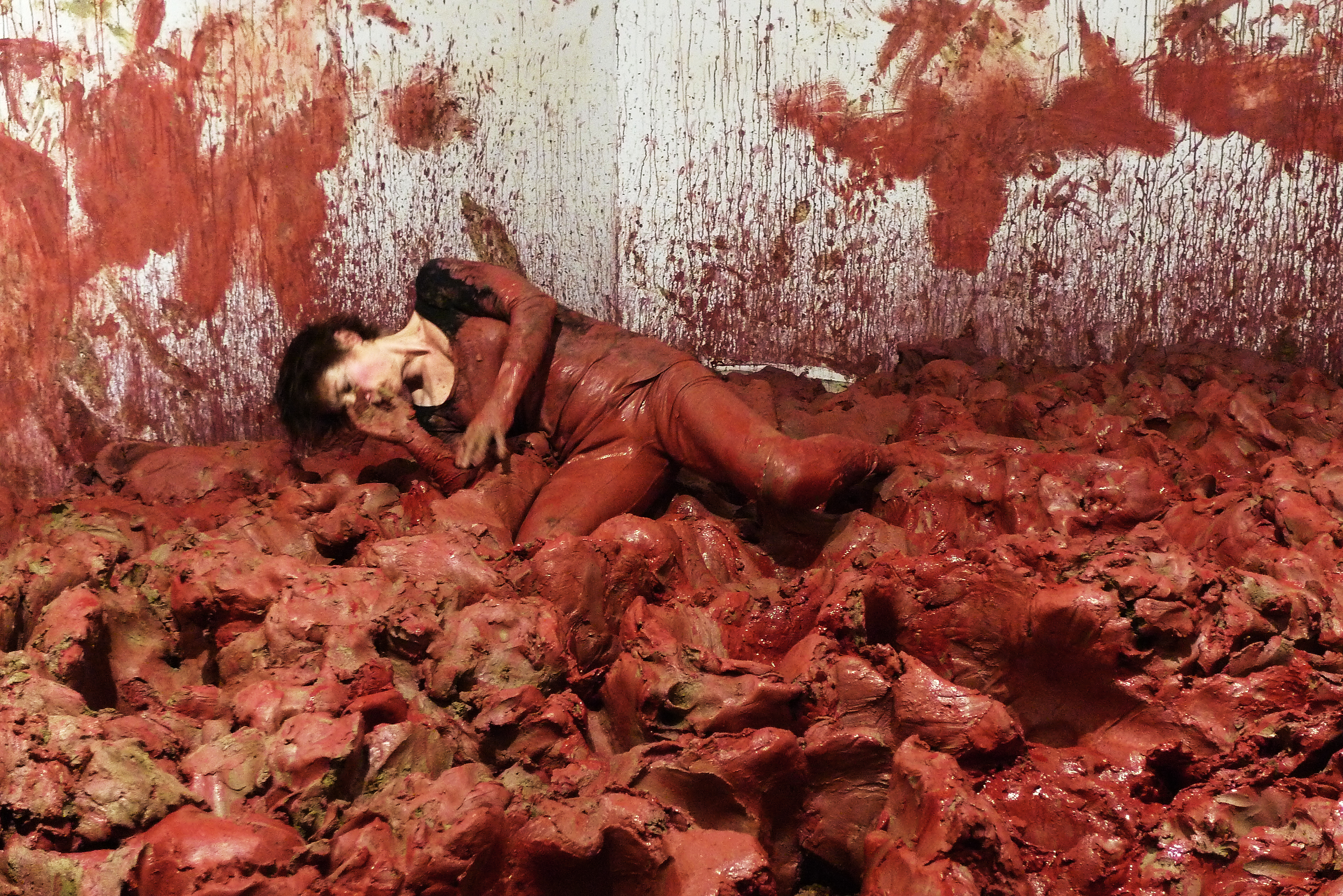
I am sucked deep into the mass of clay, I am going under. I enter into a layer of the earth in which death is revealed. I am in that other reality, where terror reigns, the reality of trenches and muddy battlefields. It is the deepest bottom, you cannot go any deeper, it cannot get any worse. Terror is inherent to the earth. Like in the churned earth of battlefields bodies were hardly distinguishable from the mud. Or were they arising out of it? When I let go of my resistance against it and surrender to it, something deep inside me opens up and starts to radiate; a great clarity expands like a force in space. The clay becomes a rich soil from which life comes forth. When facing horror and death as part of the human experience, the inversion becomes possible.
In January 2011, I brought eight tons of clay, straight from the riverbed, into the space of Gallery Punt WG in Amsterdam, the Netherlands. Kneading the earthy clay with my feet and using fabric to fold it like dough, I tried to make the material plastic, but it kept falling apart. This ripping and splitting of the material and the fabric needed to keep it together became the guiding elements in the development of a monumental sculpture on the floor of the gallery. I was at that time mourning the death of a friend, but the experience became more universal. The forms evoke decaying flesh, and I felt as if I was caring for the dead of old battlefields. The film by Marlou van den Berge follows the process of making it.
"The sound track records the grisly effort required in one human being disinterring the body of another. Helena Goldwater writes of this film: '…there is a complexity in the potentiality of meaning. The corporeal and visceral come through and lead towards an intimate work but also devastating in terms of life and death…' The clay comes from the river-washed land of the Kleine Gelderse Waard. The river slows as it nears its end and unburdens its load. It is a land made from the silt of others." – Sebastian Blackie
Tranchée
"Over the course of four weeks, Alexandra – together with a large cast of volunteers from the local community – dug a trench of thirty meters, filled it with twenty tons of clay, sculpted the clay for eight days, built a kiln around it, and fired it for ten days. The work of art was both emergent ritual and enduring work of art, a collective work akin to the medieval cathedrals coming together through the work, skill, and generosity of the community, each giving what they could – labor, money, materials – a celebration bordering on délire, delirium, with the ‘artist’ figuring as a kind of unhinged, unhinging, celebrant." – Marc Higgin
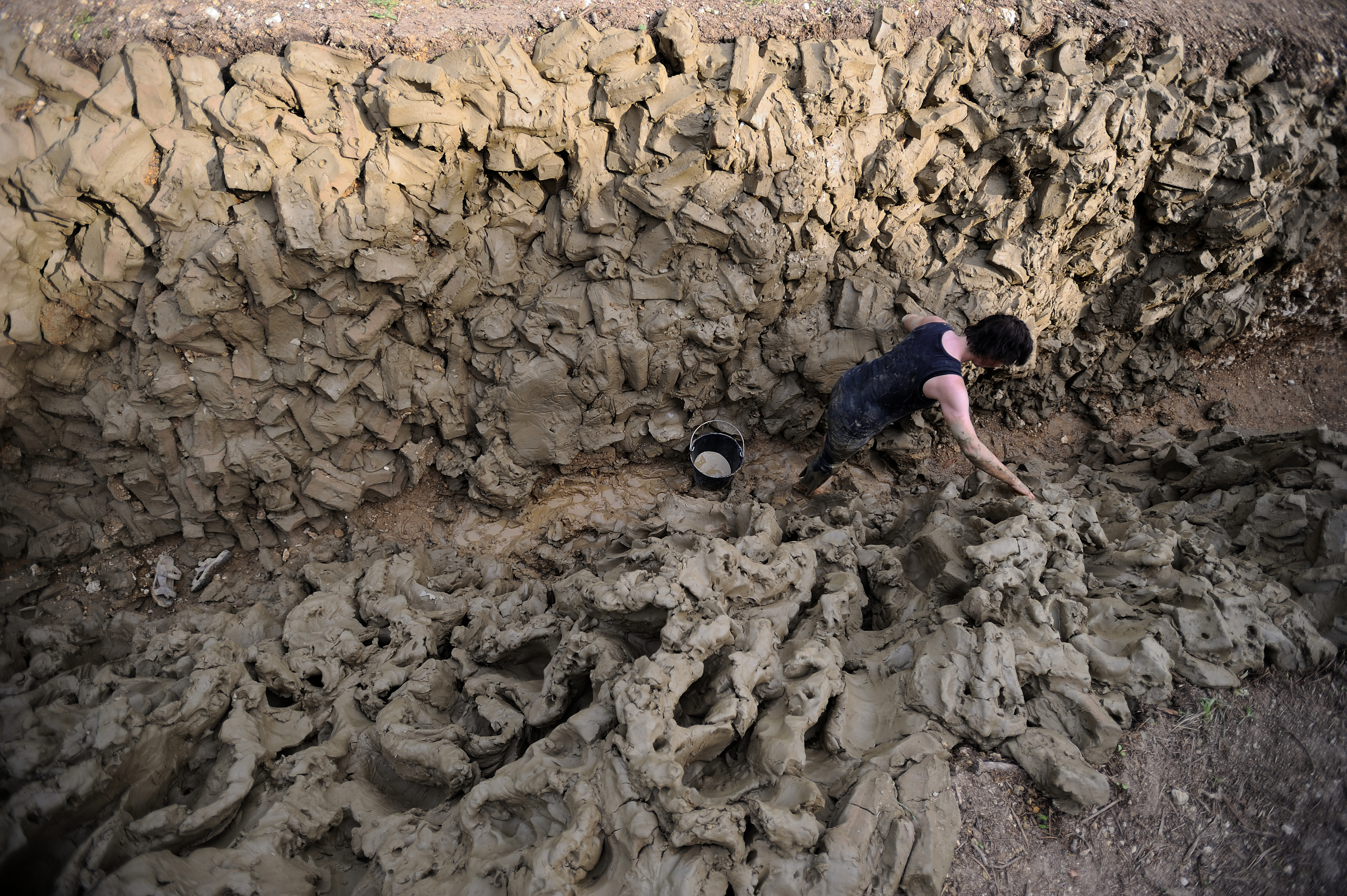
In 1916, the city of Verdun and the surrounding countryside witnessed the slaughter of hundreds of thousands of soldiers as the longest and fiercest battle of the First World War was fought there. A century later, the landscape still bears the scars of old trenches and bomb craters, and after the rain, the bones of fallen soldiers still surface from the earth. "Tranchée" (Trench) is located in a forest clearing at the open-air sculpture park, Le Vent des Forêts (Wind of the Forests), near Verdun. It consists of a fifty-meter-long trench with a central nave of fired clay walls.
For "Tranchée," I sculpted twenty tons of raw clay from a local brick-factory in a performance that lasted several days before the trench was covered by a ten-meter-long roof, transformed into a huge wood-fired kiln, and fired continuously for a week. The glowing and crackling kiln became alive, breathing in the rhythm of the stoking, a river of fire pulsing underneath its skin. The resulting permanent sculpture embodies my bodily presence in a large range of colors. My engagement with the “flesh of the earth” in a grueling physical ritual evokes one of the darkest chapters in human history.
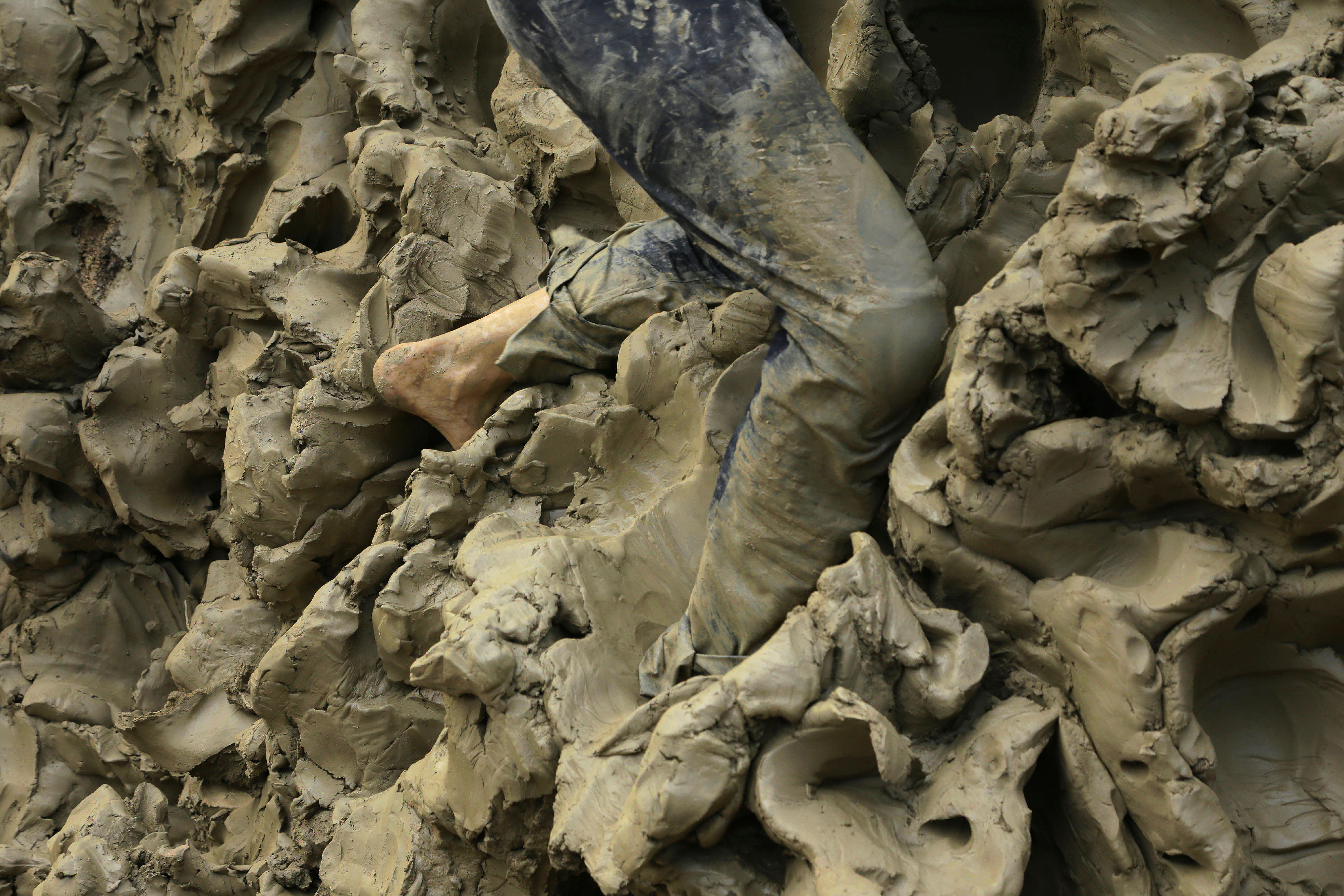 "This experience of moving deeper into the earth, both a mourning and caring for, was central to the work of Tranchée for Alexandra, a trench dug in a land where the First World War is very much a living presence. The clay became skin, insides on the out, folded between the cold of the earth and the warmth of the living." – Marc Higgin
"This experience of moving deeper into the earth, both a mourning and caring for, was central to the work of Tranchée for Alexandra, a trench dug in a land where the First World War is very much a living presence. The clay became skin, insides on the out, folded between the cold of the earth and the warmth of the living." – Marc Higgin
Projects at Le Vent des Forêts are organized to involve the surrounding community, and "Tranchée" drew on a wide range of local artisan skills. The making and especially the firing of "Tranchée" involved a large number of local volunteers, and their engagement in this process forged new social, physical, and material connections with me, each other, and with the earth.
"As an anthropologist, I couldn’t help reading how this art-as-event – as a kind of emergent ritual and as an enduring work of art – brought out and made visible these social and material relations with a power that moved people, and which allowed new social, physical, and emotional connections to take form and persist in this place." – Marc Higgin
Wood-firing is capable of preserving the immediacy and the sense of bodily presence of my work. Fire had become another natural element with which I collaborate, which in turn leaves its traces in the clay. But it was the first time that I fired such a monumental site-specific work on the spot by building a wood-fired kiln around it.
When opening the kiln, a passage into the interior of the earth was revealed. Slowly one descends into the flesh of the earth
and enters the narrow passage between two high walls full of body imprints and cracks in a wide range of colors in fired clay, from soft pinks to scorched dark grays. The traces evoke physical presence so that the viewer can identify with the creative process. The association with the violated, charred, and dismembered bodies of the war that raged in the surrounding area a hundred years ago is inescapable. But the fire has also brought out the soft and sensitive, the touch, as if the sensitivity of the inside of the body has been turned towards the outside. One descends, as it were, into the pain while at the same time experiencing the formative powers of body and earth – a gripping and transformative experience. The experience of body and matter has now become the experience of the viewer.
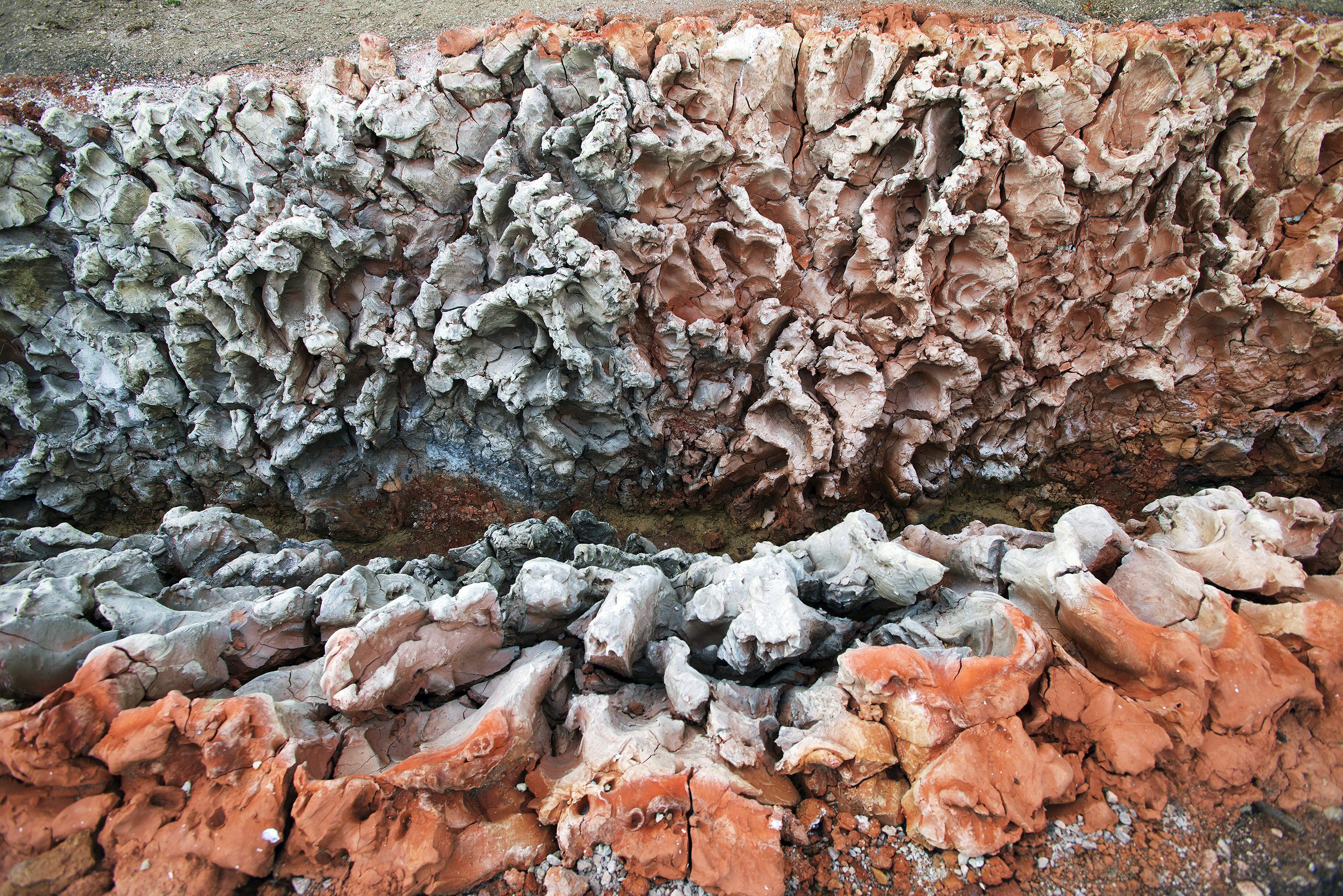
In a way, there are three performances: the sculpting of the clay, the firing, and the viewer, who descends into the flesh of the earth and passes through the work, also performs. Film is one way of recording the process, but I have always hoped that the experience is transmitted by what is visible in the clay and that it becomes an experience for the viewer, transmitted in this case by the fired sculpture.
"The forest had started its work of repossession, with grasses and wildflowers covering the burnt earth of a year ago, softening the lines leading into the trench. But the sculpture inside stood there still; all the movement of its making, from the struggle of the fight to the tenderness of the nursing touch, inscribed in the clay and set in stone through the violence of the fire. I walked through barefoot with my four-month-old son, the recent rains ankle deep, emotion caught somewhere between the impulse to get out of this claustrophobic space and the urge to look closer, to touch this cauterized skin gradually being worn down by the patient work of water, gravity, plants, and animals, fading back into the earth." – Marc Higgin
Different States of Clay
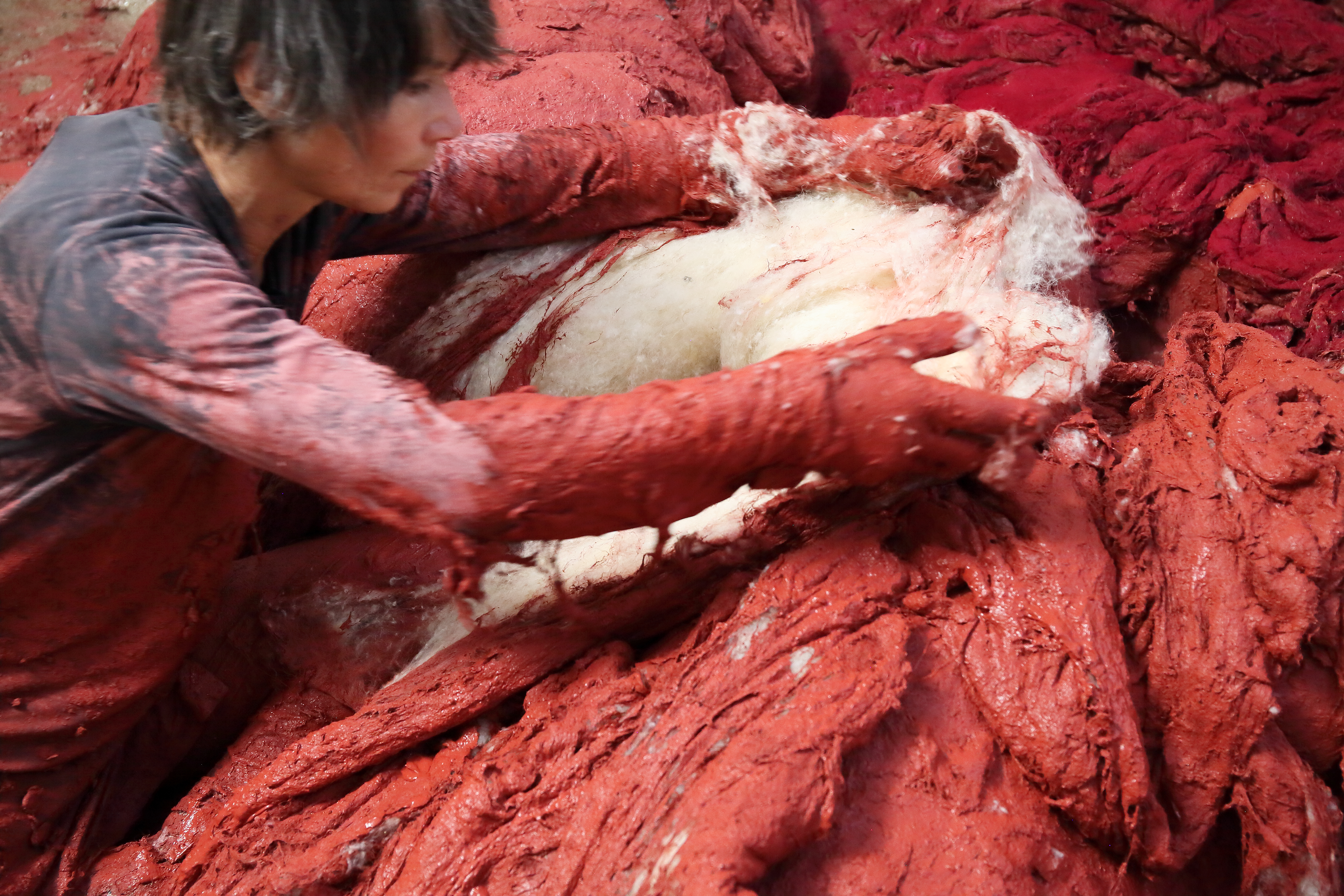
Recently, I have become more interested in clay in its fluid state, clay slip. I mix the clay slip with wool to give it consistency, referring to an age-old technique of mixing clay with straw or other material to use for building. A way of creating permanent sculptures without having to fire them.
The breath-taking landscape of the high plateau of Venabu fjellet in the mountainous region of Norway formed the backdrop for my project “Intertwining,” which I realized at the Centre for Ceramic Art in Ringebu, Norway, from half of May to half of June 2022. Every year, Torbjørn Kvasbø, director of the Centre for Ceramic Art, invites an artist to realize a project in the “fjøset,” the old cow stable in the converted former farm in which the Centre is located. Ten tons of raw clay was transformed into slip and mixed with the wool from local sheep. The special breed of sheep that roam the high plateau during the summer months, feeding on the grasses, reindeer mosses, and bushes that grow there, develop exceptional longhaired coats of wool to withstand the cold climate during winter. Filmmaker Brage Kvasbø made a film of the making process. After drying, the work has been preserved as a permanent work of art.
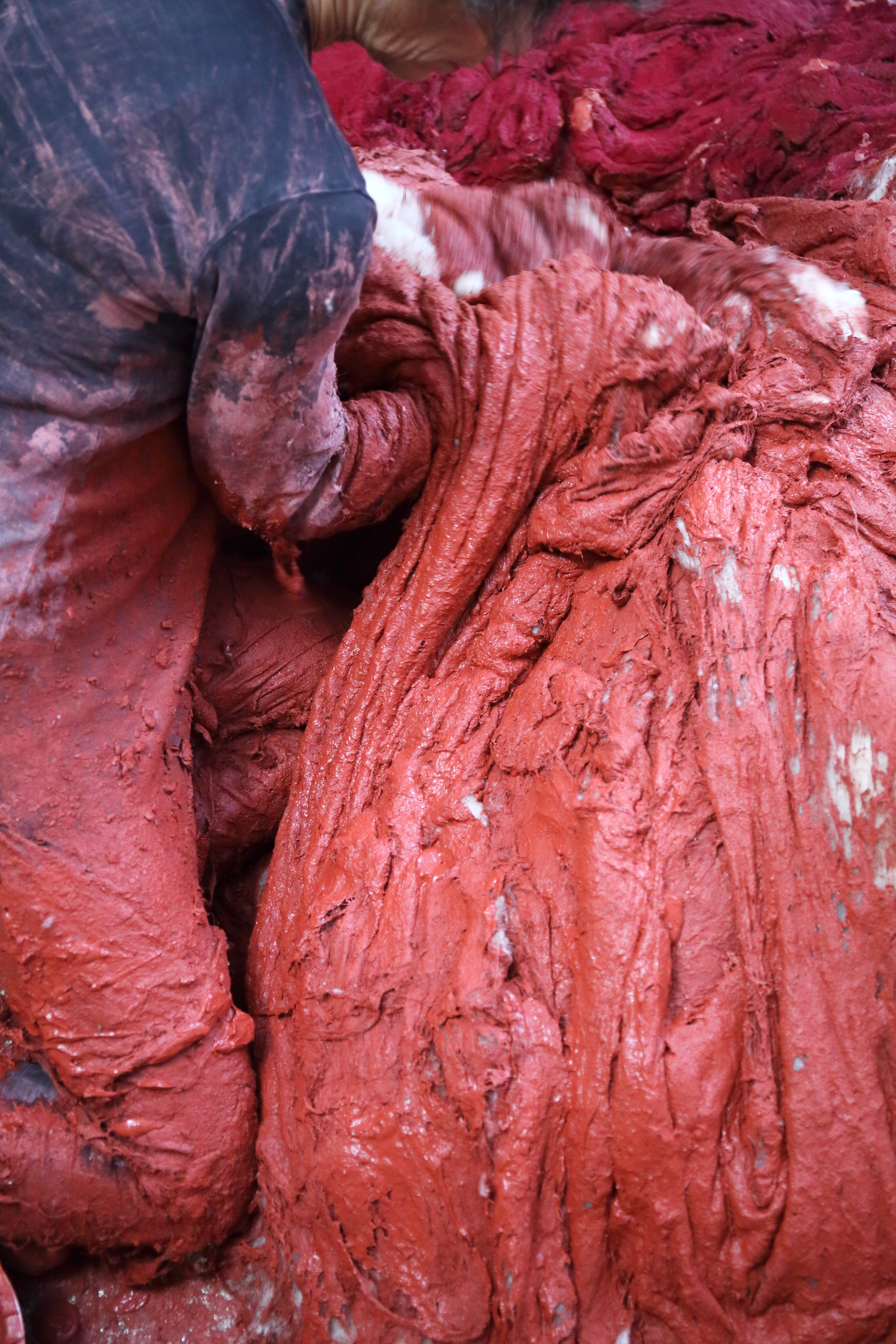 "Alexandra Engelfriet’s 'Intertwining' (2022) is an ambitious large-scale installation project in which the Dutch artist meshes two disparate raw materials: unprocessed wool and clay slip (…) She merges the two entities: transforming a disused cowshed into a sea of clay-infused raw wool, collected locally. In so doing, she creates an impossibly heavy, wet blanket that covers the entirety of the stable floor. Through an intensive physical process of bunching, pounding, massaging, and pushing, the labor of a human body immersed in earth is a spiritual performance. It is a means of exhibiting the tension between found and altered materials and erasing the boundary between humans and animals, instead creating a liminal space for the active presence of seasonal dependencies.
"Alexandra Engelfriet’s 'Intertwining' (2022) is an ambitious large-scale installation project in which the Dutch artist meshes two disparate raw materials: unprocessed wool and clay slip (…) She merges the two entities: transforming a disused cowshed into a sea of clay-infused raw wool, collected locally. In so doing, she creates an impossibly heavy, wet blanket that covers the entirety of the stable floor. Through an intensive physical process of bunching, pounding, massaging, and pushing, the labor of a human body immersed in earth is a spiritual performance. It is a means of exhibiting the tension between found and altered materials and erasing the boundary between humans and animals, instead creating a liminal space for the active presence of seasonal dependencies.
"Clad in her wetsuit, she too is working "in the raw" as a means of orchestrating a massive sculptural project, but also a mystical one, invested in the transfiguration of substance, altering the body of her substrate, wool, using clay as a catalyst, while also altering her own bodily relationship to the mass and volume of clay itself. It is a medium that consumes her own body in the space of the stable itself, a sensual overpowering. In 'Intertwining,' then, the entwined sheep’s body and the clay body fuse together to produce a site, and the site itself becomes a seasonal refuge, marked by embodiment." – Jenni Sorkin
A lot of work has gone into softening large amounts of too-dry and hard clay into a plastic state by adding water and kneading it. Over the years, I have developed a feeling for when the clay reaches just the right consistency to let itself be shaped: soft enough to react to pressure easily but hard enough so it doesn’t lose its shape. To find and maintain this state requires ongoing work, especially in the summer when it dries fast.
After all these years spent being immersed in tons of matter, I am now looking for more light and lightness in my work. Also, the desire to make lasting work has imposed itself.
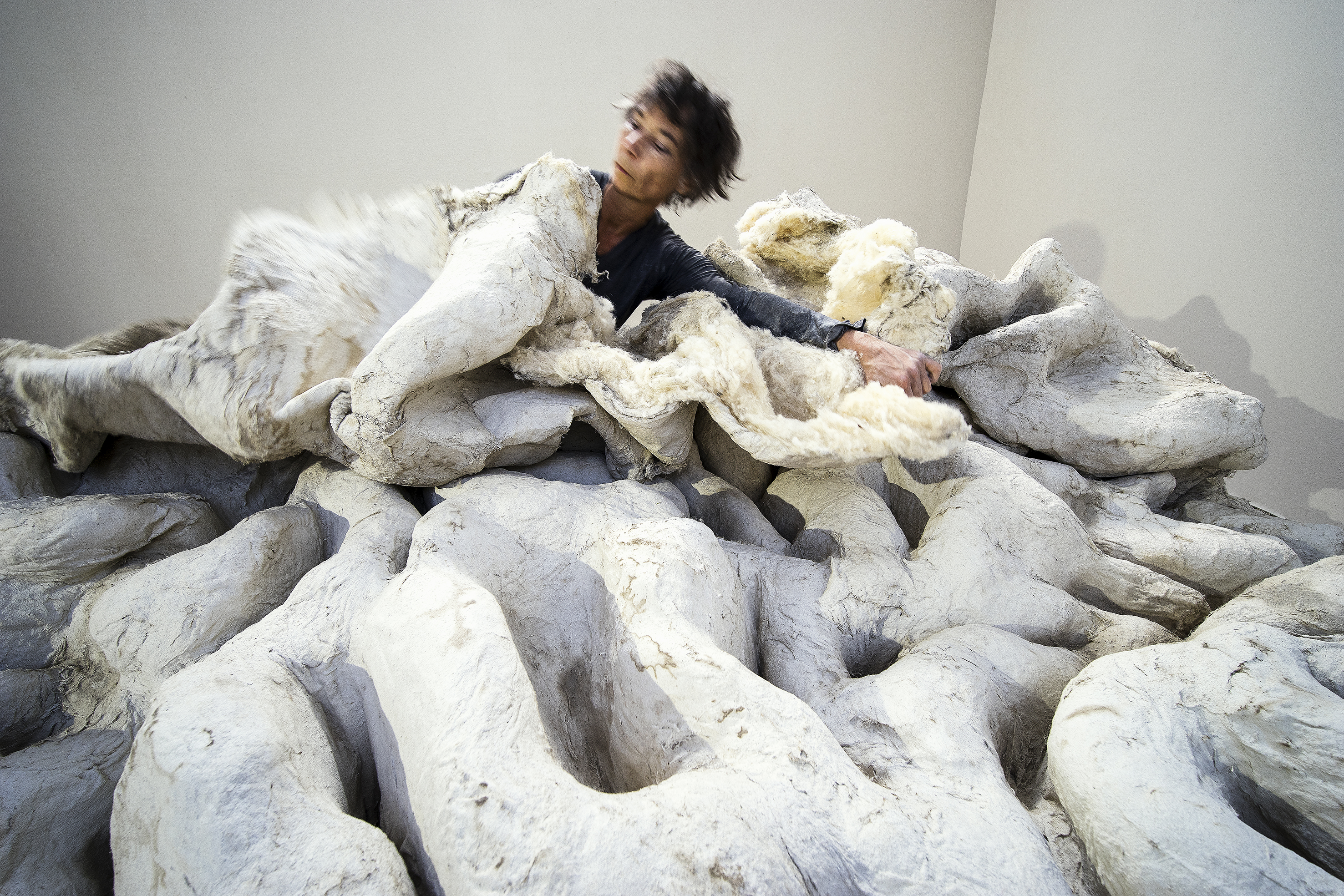 During the COVID years, I realized two transitional ephemeral works in my studio, “Shedding Skin I and II.” A thick layer of soft, white clay on the floor of my studio was first shaped into a “sculptural landscape.” It was consequently covered with a skin consisting of a thin layer of wool drenched in clay slip. When the skin was dry, I stripped it of the clay during a two-day performance, captured on camera in stop motion. The clay shed its skin. Another form of transformation and metamorphosis.
During the COVID years, I realized two transitional ephemeral works in my studio, “Shedding Skin I and II.” A thick layer of soft, white clay on the floor of my studio was first shaped into a “sculptural landscape.” It was consequently covered with a skin consisting of a thin layer of wool drenched in clay slip. When the skin was dry, I stripped it of the clay during a two-day performance, captured on camera in stop motion. The clay shed its skin. Another form of transformation and metamorphosis.
During the winter of 2022, the American/French photographer Alison Harris followed the making of a permanent sculpture made with wool and clay-slip mixed with red ochres. These materials were shaped on a previously sculpted mass of clay mixed with vermiculite. While the clay-slip was still wet, I dusted it with a bright fuchsia-colored pigment, which attached itself to the wet slip. When the skin of wool, clay-slip and pigment was hard, the clay was taken away from under it. I am now in the process of developing this process further and creating a lasting body of work.

